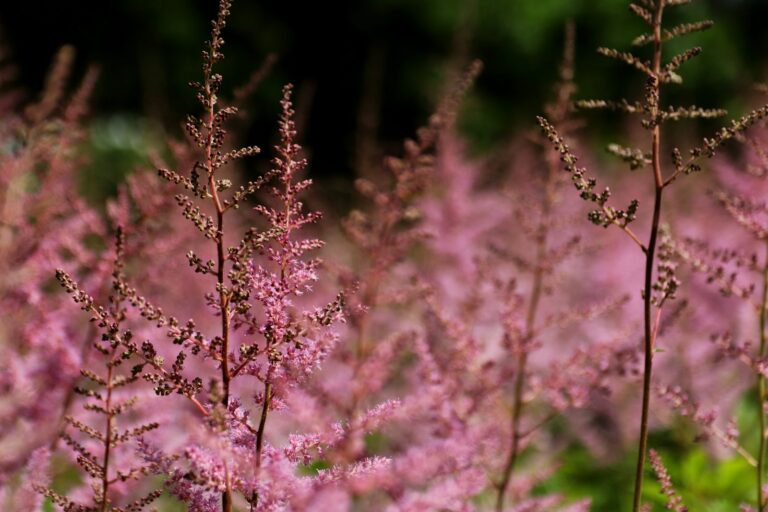Best Time to Plant Astilbe: Seasonal Planting Guide
Your astilbe blooms for three weeks while neighbors enjoy six weeks of color. The difference comes down to planting timing that allows proper root establishment before stress periods arrive[3]. Here’s how to time your astilbe planting for maximum performance.
💡Once you understand optimal timing, learn where to plant astilbe for the best microclimate conditions in your landscape.
Understanding Astilbe Planting Windows
For this purpose, Astilbe flourishes in cool, moist conditions that promote root development and do not present heat stress. Two perfect planting windows are spring after a last frost and fall before the first hard freeze.
💡 Return to our complete astilbe guide for comprehensive cultivation information, or review hardiness zone requirements to understand your regional timing considerations.
Plants on zones 3-7 should be transplanted after the last frost and may take place mid-April to mid-May[1]. In your zone, fall planting works best when finished 6-8 weeks before the first frost[1].
Spring Planting: The Preferred Season
Spring is the most favoured planting season for astilbe in most growing regions. Plant before mid-semester after the temperature of soil has warmed above freezing but before the heat comes[3]. The timing is such that root establishment is in a suitable state of cool and moist. Growing in the spring makes astilbe have abundant root systems all over the year, and will enter winter fully installed the year afterward.
Spring planting gives astilbe the entire growing season to develop roots before winter dormancy arrives.
Zone-Specific Spring Timing
This time of year for planting the particular plant is dependent on the type of hardiness zone:
- Zones 3–4: Plant by May 15 after the previous frost danger has worn off[1]
- Zones 5-7: Plant around April 15 when the workable soil begins to appear[1]
- Zones 8-9: Extended spring planting windows from October through March since we see mild weather in winter[1]
During the window of spring, be sure to plant as bare roots or get a potted transplant for best establishment.
💡 Match your planting timing with climate-specific challenges and understand what makes astilbe unique as a shade-loving perennial.
Advantages of Spring Planting
Spring planting is really rewarding for astilbe success:
- Fresh air (cool temperatures and spring rains) help reduce watering during this crucial establishment season with steady springy temperatures and rain evenly during the vital establishment period
- Plants have the full growing season to develop roots in before winter dormancy is in sight
- In the first year, initial spring planting can bring forth some blooms and flowers, but full florals are generally displayed in year two
- Long established period ahead of summer heat minimizes transplant shock and mortality
Fall Planting: An Alternative Window
When spring timing proves impractical, fall planting offers a different opportunity. Plant 6-8 weeks before your area experiences its first hard frost in early fall[2]. This ensures that roots form before the ground freezes. Fall-planted astilbe goes dormant for winter due to development of early roots, and comes back strongly the next spring. Plants set roots more quietly than spring plantings, but they quickly re-establish themselves.
Calculating Your Fall Deadline
Now calculate your fall planting deadline by going backward to your first frost date:
- Zone 3-4: Fall planting is anticipated to reach the end by mid-August[1]
- Zone 5–7: Can take into early September[1]
- Warmer zones 8-11: Extend their planting in the fall into November owing to later frost dates[1]
Allow plants the full establishment period to avoid the frost heave damage during winter.
Fall Planting Considerations
Fall planting is more moisture intensive than spring planting. Cooler temperatures reduce evaporation but inhibit root growth:
- Do water it well at planting, then weekly soil moisture
- Post-planting, apply 2-3 in mulch to insulate developing roots and avoid frost heave
- Astilbe planted for the fall often skips blooming the first season, instead directing energy to root development to bloom for the season
💡 Coordinate fall planting with fall care preparation techniques and winter protection strategies for successful establishment.
Avoiding Summer Planting
Astilbe establishment is difficult to maintain during summer planting. Do not plant from late May to August in nearly all climates[5]. Excessive heat and increased evaporation stress plants before roots are established. Astilbe plants are sensitive to drying out, and the increasing season leads to extensive watering needs even above practical levels.
It takes time, not a breeze, to get them on your soil if you have to plant them in the summer, and make sure you do in fact put them under good (and daily) shade and deep watering so as to prevent scorching of the leaves and also to avoid plant death.
💡 Understand why timing matters by learning about environmental stress factors and summer care challenges that impact establishment.
Climate Zone Timing Strategies
Your best timing for planting depends on your climate zone:
| Zone Type | Recommended Season | Timing Window |
|---|---|---|
| Cold zones (3-5) | Spring only | After last frost danger passes |
| Moderate zones (6-7) | Spring or fall | April 15 or early September |
| Hot zones (8-9) | Fall through winter | November through February[1] |
Cold climate gardeners in zones 3-5 have the greatest success planting in the spring on winter days and will do best when frost danger is no longer an issue. This short growing season makes the earliest planting important to establish before winter. Moderate weather zones 6-7 are good for growth in spring or fall. Hot climate zones 8-9 should focus on planting of fall through winter seeds to the extent possible to prevent planting from occurring in hot summer heat[1].
Bare Root vs. Container Plants
Bare Root Astilbe
Bare root astilbe needs to be sown immediately the instant they arrive. When air is applied to these dormant roots, they cool and dry easily:
- Place within 48 hours of bare root collection
- If instant planting isn’t available, root it in moist peat moss in a cool area for one week
- Spring is still the norm for shipping and planting bare root astilbe
- The dormant roots respond to fast planting in cool, moist spring soil
Container-Grown Plants
Container-grown astilbe provides time for cultivation which is more relaxed than bare roots. Potted plants can be planted during the growing season with proper moisture. Buy container astilbe in spring for planting or put in pots to put them in until fall. Water astilbe in pots frequently as one waits to plant. Container-grown plants grow faster than bare roots because their root systems are stable for the duration of transplant.
💡Proper soil preparation before planting dramatically improves establishment success regardless of whether you’re planting bare roots or container-grown specimens.
Planting Technique and First-Year Care
Correct planting technique is as important as timing for the success of astilbe:
- Dig hole dimensions twice as wide as the root system and also 4-6 inches deep
- Place crowns 1-2 inches below ground level and roots are fanned downward and outward
- Backfill with original soil, amended with compost
- Once planted water well to settle soil around roots and no air pockets
- Mulch is a good way to conserve moisture and cool down soil
Long-term first-year establishment determines astilbe durability. Newly planted astilbe needs constant water throughout first growing season. Fresh astilbe can only require a regular watering throughout the initial growing season to maintain a steady supply over its first growing season of soil moisture. Once or twice weekly, provide 1-2 inches of water per session. Maintain moisture without soil becoming wet.
💡 Master moisture management with our comprehensive watering requirements guide and learn proper spacing techniques for optimal air circulation.
💡Follow our detailed planting instructions for step-by-step guidance on hole preparation, depth, and spacing requirements.
Watch plants when it is hot or dry, and get more water done if foliage is wilted. Established astilbe tolerates short dry periods less; its ideal condition is regular moisture.
Division Timing and Maintenance
The seasonally consistent divisions move along a continuum similar to the timing for the original planting. Disperse clogged astilbe bundles every 3–4 years to keep vigor high[4][6]. Divide in spring when new growth appears, or in early fall, when blooming ends[6]. Dig entire clumps and cut divided segments off with 3-5 eyes each. Replant divisions the same depth as the original plant immediately.
💡 Master the complete division process with our dividing astilbe guide and coordinate with transplanting instructions for moving established plants.
Water and mulch to facilitate establishment.
Dividing astilbe every few years keeps plants vigorous and prevents overcrowding that reduces flowering.
Regional success depends on zone-specific timing variances that allow regional success. Cold zone gardeners need to prefer spring planting and not fall planting after mid-August. Plants in cool zones should start in the spring, spring-only during which time they are more prone to fall planting as the establishment stress is minimized. Moderate zones also benefit from plantings on the ground during the fall when the temperature falls as the establishment is less stress inducing. Hot zones encourage planting at their most cool times, usually during November through February. Match planting season to climate conditions in your area rather than reading seasonal instructions.
💡Coordinate your planting timing with spring planting care routines for optimal establishment, or review fall care considerations when planting in autumn.
Conclusion
Planting astilbe just when is best sets you up for many of those year-round blooms and some gorgeous leaves. Spring planting after the last frost is the longest establishing period and works best across most climates. If the gardeners miss the first frost they can go for fall planting (6-8 weeks in advance) instead. Plan timing of hardiness zones then set up sites with the soil amendments needed to plant sturdy roots and water for vigorous growth.
💡 Continue with proper site selection, detailed planting techniques, and fertilizing schedules for long-term success.
Key Sources:
[1] Astilbe Zone Planting Guide | Bonnie Plants
[2] Astilbe Planting & Growing Guide | Easy To Grow Bulbs
[3] How to Plant and Grow Astilbe | Better Homes & Gardens
[4] How to Grow and Care for Astilbe | Clemson Extension
[5] How to Grow Astilbe | American Meadows
[6] Growing Astilbe in Iowa | Iowa State Extension
Lily Morgan is a home gardener. She grows houseplants and designs small-space gardens. She shares what she learns from experience. Lily offers simple, practical tips for plant lovers. Her goal is to help others garden with confidence. She wants to help them grow, one leaf at a time.


